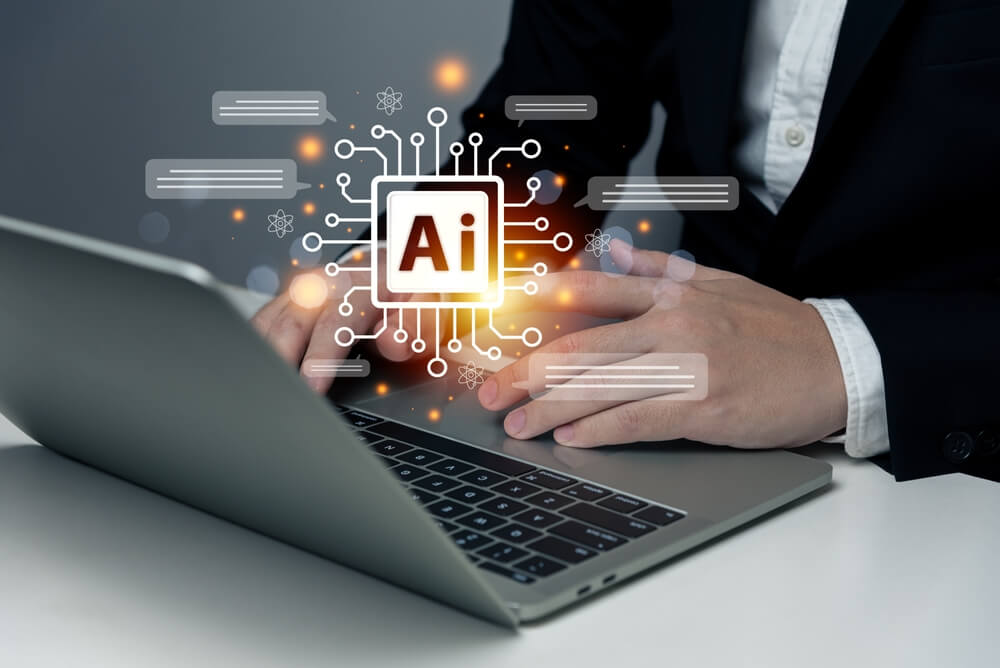
Healthcare Content Marketing and 5 Ethical Uses for AI
Recent news highlights the ethical implications of artificial intelligence (AI). Is it still ideal to use for healthcare content marketing? The answer is yes.
It helps you streamline workflows without compromising user data and compliance. This article discusses this in greater detail:
- What AI means for B2B healthcare marketing.
- Different ways a competent content marketing agency uses it.
Your competitors now use AI. Be more aggressive in your content marketing or get left behind. Read below to learn how to responsibly and ethically use this tool.
Let’s go!
We're the top B2B Content Marketing Agency in America. Watch the video below to learn why.
What Does AI Mean for B2B Healthcare Marketing?
Artificial intelligence (AI) refers to computer systems or software that perform tasks normally requiring human intelligence. These range from visual perception to speech recognition and decision-making.
The concept of AI has been around for ages. Some even traced it back to ancient civilizations. The enormous bronze robot Talos, made by a god for the Greeks, is a good illustration.
It became popular during the cybernetics age, which was from the 1940s to the 1960s. Since then, AI’s role in different industries has grown.
In healthcare, it powers robotic surgeries and automates electronic health records. It also runs population health analytics and increasingly shapes modern marketing in three ways:
- Decreasing operating costs.
- Streamlining workflows.
- Improving stakeholders’ (patients and staff) experiences.
Automating repetitive tasks lets marketing teams deliver more efficient work. Chatbots now handle routine website and social media inquiries. It frees up employees’ time for high-value jobs.
AI content tools generate 50% to 70% more than human writers alone. The volume of optimized, personalized content sustains lower customer acquisition costs.
Additionally, the technology enhances collaboration and content approvals between siloed departments. For instance, branding and compliance have become more consistent across all facilities. With customizable analytics dashboards, marketers gain data-driven insights to inform strategy.
AI introduces new ethical challenges around transparency, privacy, and bias, despite its benefits. The best marketing strategy designs avoid codifying biases or compromising confidentiality.
All of these reasons mean that hiring an experienced healthcare marketing agency is crucial. The right partner optimizes the tech stack while putting people and compliance first.
In the end, AI allows you to improve experiences by removing friction points. It also develops more agile, scalable operations without sacrificing the human touch.
Five Ways AI Helps in Healthcare Content Marketing

AI is valuable in almost all content marketing aspects and stages. It is particularly useful in the following ways:
1. Segmenting Broad Audiences
AI helps marketers garner insights from patient data to segment target audiences with these two steps:
- Securely analyzing demographics, behaviors, interests, and clinical profiles.
- Identifying user groups without compromising protected health information (PHI).
To be more specific, the technology aggregates and anonymizes information to comply with the Health Insurance Portability and Accountability Act of 1996 (HIPAA) regulations. For example:
- It combines data from thousands of patient health records to analyze broad trends.
- It also removes identifiable fields. These include names, birth dates, addresses, and diagnoses.
- The best marketing agency collaborates with internal or external IT to employ privacy controls. One such technique is limiting marketers’ authorized data access.
Healthcare marketers break down the aggregated information into smaller audiences. They then tailor content to match specific conditions, needs, or care stages.
Suppose that AI tracks website usage trends. It determines that middle-aged mothers are interested in nutrition and weight management. With this insight, a children’s hospital develops a content series on healthy family cooking tips. They also target mothers in that segment with healthcare paid ads and personalized emails to promote the content.
For healthcare systems, better audience targeting brings substantial benefits. It makes messages more relevant. This increases campaign engagement and conversions.
Most importantly, useful content educates patients and addresses their concerns. This fosters closer provider-patient relationships and stronger brand loyalty.
2. Automating Repetitive Content
AI is best for automating routine content-marketing tasks. These refer to large-volume jobs requiring output consistency. Examples are patient post-op instructions, procedure descriptions, and consent forms.
AI content tools also develop original content ideas matching healthcare guidelines, legal policies, and brand voice.
For instance, AI analyzes past content such as blog posts, landing pages, and social media captions. It also studies competitor articles. The system then learns and matches the ideal brand tone, messaging, and terminology with the target audiences.
Depending on its design, AI also references healthcare content guidelines and regulations around claims, disclaimers, et cetera. With a robust dataset of on-brand, compliant marketing materials, the technology automatically generates new blog posts, social copy, FAQs, and more.
Auto-generated content demands a human editor to guarantee quality and industry compliance. However, AI automation enables marketers to produce content at scale. In the process, marketers devote more resources to high-level strategy and creativity.
3. Personalizing Patient Experiences
Because AI segments audiences, it promotes one-to-one personalization. Specifically, it customizes messaging and content according to the markets’ unique attributes.
These include the following:
- Diagnosed conditions. For example, the workflow sends an email about new migraine treatments to a chronic migraine patient.
- Treatment plans. The system personalizes post-discharge information based on prescribed medications, upcoming appointments, or recovery instructions.
- Health interests. Using the person’s past engagement data matches content to a patient’s interests such as nutrition, fitness, and mental health.
- Demographics. AI adjusts the reading level, language, or cultural references to make the article more meaningful. An example is simplifying content for elderly patients.
AI systems leverage machine learning to refine personalized content through A/B testing. Over many iterations, they determine the optimal combination of variables when personalizing content for each patient.
This hyper-personalized approach provides the right information at the right time. Patients feel understood and are more receptive to useful, tailored engagement. It also elevates your expertise, credibility, and trustworthiness.
4. Optimizing Content Campaigns
One of AI’s biggest advantages is optimizing content marketing campaigns. It identifies opportunities to improve engagement and outcomes based on data.
| Marketing Channel | Metrics AI Measures |
|---|---|
| Website analytics | Page views, bounce rate, dwell time, and scroll depth |
| Email marketing | Open rates, click-through rates (CTRs), and subscriber gain/loss |
| Social media | Impressions, reach, and engagement rates |
| Search engine | Organic traffic, rankings, and CTRs |
| Readability | Flesch-Kincaid grade level |
| Media performance | Views, completion rate, and downloads |
AI collects this multivariate data and looks for patterns and correlations to model the ideal content attributes and formats for specific audiences. These include the following:
- Brand voice
- Headline styles
- Visual aids
- Calls to action
- Length
- Keywords
For example, AI data analytics pinpoints that Instagram posts with infographics outperform text-only posts among Millennial patients. It also detects that email subject lines phrased as questions have a 10% higher open rate among women between the ages of 45 and 65.
This optimization level makes healthcare content marketing more meaningful, valuable, and cost-effective.
5. Making Content Accessible
You have the legal and ethical obligation to ensure that your services and information are accessible to patients with disabilities. Meeting accessibility standards, though, is challenging.
For instance, developing multiple content formats for different abilities takes considerable time and effort. This is where artificial intelligence lends a helping hand.
AI tools automate key accessibility adaptations to boost inclusiveness and compliance.
- Speech recognition and natural-language generation let virtual assistants deliver information through conversational voice interfaces. It assists those who have difficulty reading text content.
- Machine learning systems add accurate closed captions to videos in seconds rather than hours. Automated captions open visual media to deaf or hard-of-hearing audiences.
- AI writes detailed alt-text descriptions for images. It makes visuals more usable for the blind and visually impaired.
- The technology optimizes reading levels while retaining medical accuracy for those with cognitive disabilities.
- Smart tagging and metadata creation help users locate information quickly within healthcare sites and apps. Enhanced search and navigation benefit those with cognitive and learning disabilities.
AI accessibility solutions mean adapting content for broader audiences. This way, you guarantee equitable and inclusive patient-centered content access.
Summing Up
AI-powered healthcare content marketing helps you create better patient experiences. It provides useful information across digital channels. It streamlines repetitive processes to give you more time for core activities. These include focusing on giving quality patient care.
Do you need content support? Digital Authority Partners (DAP) is a content marketing agency specializing in your niche. We combine innovation and creativity to tailor data-driven strategies to your needs. Contact us today to learn more.
Want To Meet Our Expert Team?
Book a meeting directly here




